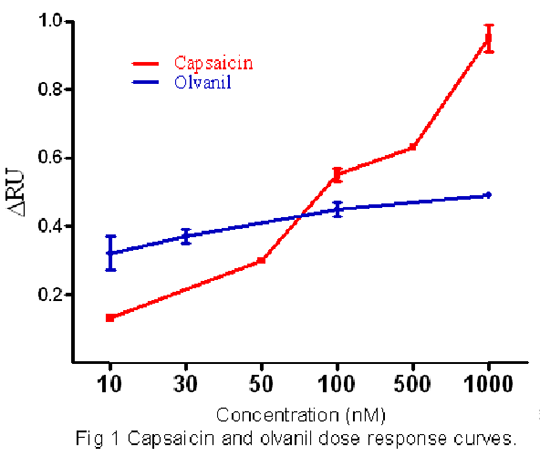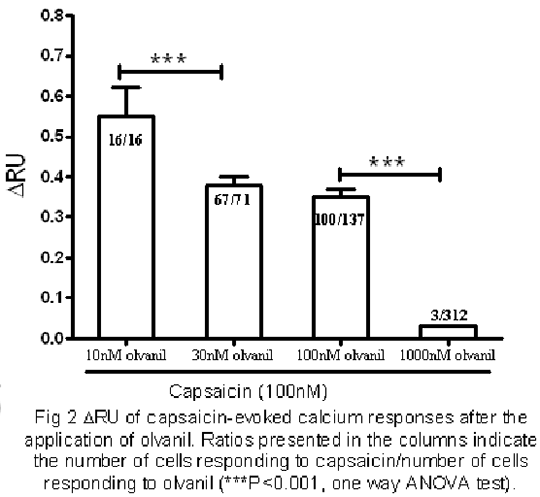Desensitisation of TRPV1 receptor by Pungent And Non Pungent Agonist In Cultured Rat Dorsal Root Ganglia cells TRPV1 is a nonselective cation channel which is a key molecule involved in chronic pain states, such arthritis, cancer and neuropathy (1). Desensitization of this receptor by different agonists provides the basis of the use of these drugs as analgesics. However, the undesired side-effects of the pungent TRPV1 receptor agonists such as capsaicin have limited their use. Previous studies were conducted to generate capsaicin analogues which were devoid of pungency such as Olvanil (NE 19950), palvanil and arvanil (2, 3). The aim of this study is to analyze the correlation between TRPV1 desensitisation by pungent and non-pungent agonists and the kinetics of the calcium signal evoked by these compounds. Sprague–Dawley rats (180-200g) DRG cells were cultured overnight and loaded with the calcium-sensitive ratiometric dye Fura 2-AM. Effects of the TRPV1 agonist capsaicin (10, 50, 100, 500, 1000nM), and olvanil (10, 30, 100, 1000nM) on intracellular Ca2+ concentrations [Ca2+]i in small DRG cells were measured. In order to study the desensitisation of TRPV1 by different agonists, cells were exposed to olvanil (10, 30, 100, 1000nM) for 1 minute, after a 45 min of wash period; cells were exposed to capsaicin 100nM for 1 minute. [Ca2+]i are presented as mean ± SEM differences in fluorescence (340/380nm emission ratio units, ∆RU) which were calculated by subtracting the baseline ratios from those obtained during drug suprafusion. Latency to peak of the calcium response evoked by capsaicin and olvanil was measured using Microsoft Excel. All procedures were carried out in accordance with the Animal (Scientific Procedure) Act 1986 and IASP guidelines. Capsaicin (10, 50, 100, 500, 1000nM) and olvanil (10, 30, 100, 1000nM) produced robust increases in [Ca2+]i in DRG cells (Fig. 1). This increase was blocked by 5'-Iodoresiniferatoxin (1µM). All cells that responded to olvanil (10nM) also responded to capsaicin (0.55 ± 0.07 ∆RU). Nearly all cells (95.5 ± 6.4%) that responded to olvanil (30nM) also responded to capsaicin (0.38 ± 0.02 ∆RU). Increasing the concentration of olvanil to 100nM was accompanied by a reduction in the percentage of cells responding to capsaicin (76.3 ± 14.4%), and a reduction in the peak response to capsaicin (0.35 ± 0.02 ∆RU). Exposing the cells to 1µM olvanil completely desensitised the cells to capsaicin (Fig. 2). The latency to peak was not significantly different between different concentration of the TRPV1 agonists, olvanil (142.5 ± 55.8, 76.8 ± 3.8, 80 ± 8.6, and 82.4 ± 3.4 seconds respectively, capsaicin (99.5 ± 10.6 seconds. When studying the correlation between the latency to peak of olvanil-evoked response and the capsaicin-evoked calcium response that follows, no significant correlation was detected (R2=0.005, n=202).
In summary olvanil evoked a smaller calcium signal, in comparison to capsaicin, but it was more effective at desensitising TRPV1. When comparing the kinetics of the calcium responses of these two agonists, it was clear that there was no difference in the latency to the peak response to capsaicin or olvanil and, therefore, this is unlikely to contribute to differences in desensitisation of TRPV1. References (1) Christoph T et al. (2006). Biochem. Biophys. Res. Commun. 350(1): 238-243 (2) Brand L et al. (1987). Drugs Exp Clin Res 13(5): 259-265 (3) Wrigglesworth R et al. (1996). J. Med. Chem. 39(25): 4942-4951
|



